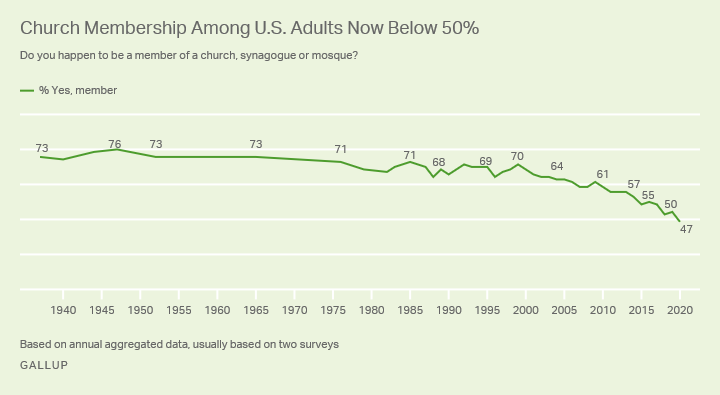It is often easy in our lives and ministries to become like an ostrich, with our head in the proverbial sand. We are busy. There are so many people and things that need our attention.
In an effort to conserve our energy and complete the tasks we must do, we can often go into maintenance mode. Doing what we need to do to get the job done. The Sundays come week in and week out. We check with our ushers or staff members responsible for asking, “What are the church attendance statistics?” “Are we keeping pace?” “Are we growing? Or are we in decline?”
Church attendance is always on the minds of every pastor, whether they would admit it or not. It is not a bad thing to take a gauge of the work you and your team are putting in. People often vote with their feet.
This can also be the case with church attendance. It can be hugely helpful to take a step back and look at the larger picture. Look not only at your church but at the church nationwide. What is God doing as a whole? Church attendance statistics can be good markers for you and your team. They can also provide points from which you can pray for change.
In this article, we’ll explore everything you need to know about church attendance and give you 7 important statistics about church attendance. These will help you learn more about how you can learn and guide your church, as well as know what you should be praying for in the church of America.
Let’s dive in.
Estimated reading time: 1 minute
Table of contents
Looking at Church Attendance

Church attendance refers to how often people go to church or other religious services. It’s important for church leaders to understand this because it can give insight into the health and growth of their congregation. When Christians attend church regularly, it shows a commitment to their faith and helps build a strong community.
Regular attendance also supports the church in many ways, like through donations and volunteer work. Knowing how many people attend religious services helps leaders plan and organize church activities more effectively.
Measuring Church Attendance
To measure church attendance, churches often use surveys or count the number of people at services. It’s important to remember that these measurements can have margins of error. Margins of error mean that the numbers might not be exact, but they give a good estimate.
Even with these small errors, knowing how many people attend religious services can help church leaders see trends over time. For example, if attendance is dropping, leaders might decide to make changes to attract more people. On the other hand, if attendance is growing, it can show that the church’s efforts are working.
Why Church Leaders Should Care
Church leaders should care about religious attendance because it reflects the engagement of their congregation. When more Christians attend church regularly, it means that more people are participating in the community and growing in their religious beliefs. This participation is crucial for the church’s mission of spreading faith and providing support to its members.
Additionally, higher regular church attendance can lead to more resources for the church, which can be used to expand programs and help more people. By understanding and focusing on attendance, church leaders can better serve their community and fulfill their mission.
7 Church Attendance Statistics

Now that we’ve covered church attendance, let’s dive into our list of the top 7 statistics about church attendance that should drive you to prayer. These cover all kinds of attendance at religious services, like weekly church attendance, monthly church attendance, and more.
Let’s jump in.
1. Regular Attendance
Gallup poll reports that 40% of Americans when asked say that they attended church regularly (Catholic, Mainline, and Evangelical).

The real numbers of those who actually attend are closer to 20% – 17.7%. 52 million instead of 132 million. This large discrepancy in church attendance statistic reporting is called the “Halo effect”. People inherently feel that it is better to report that they are regular church attendees rather than not.
This is unfortunately the case with most church statistics. The real truth might be even worse than what the stats say. This is why it’s important to be in prayer about these things. We know that only God has the power to fully shift culture and hearts, so while we should do what we can in our churches, it’s important to never stop praying for a move of God.
2. Attendance Decline
The General Social Survey by Pew Research says 4 in 10 Americans claim to go to church every week. 44% belong to a congregation says the Association of Religion Data Archives. Mainline churches, (Episcopal, Presbyterian, Lutheran, Anglican, and Methodist) have been experiencing the steepest decline according to church attendance statistics. According to the Barna group, unless there is a drastic change, they are trending toward extinction within 4 to 5 decades.
The extinction of American church attendance in 4 to 5 decades could have profound social and cultural implications. Churches have historically been central to community life, offering not only spiritual guidance but also social support, charitable services, and a sense of belonging. Without regular church attendance, many of these community functions might diminish or disappear, leading to a potential increase in social isolation and a decrease in volunteerism and charitable giving.
The decline in church attendance could also reflect a broader shift in religious beliefs and practices, possibly moving towards more secular or individualized forms of spirituality. This shift might influence moral and ethical frameworks, traditionally guided by religious teachings, leading to changes in societal norms and values.
Moreover, the disappearance of church communities could impact the political landscape, as religious groups have often played significant roles in advocacy and policy-making. Overall, the extinction of church attendance could signal a major transformation in American society.
3. Holding Steady
Historically African-American churches are a bright spot on the horizon. They are holding their own in the church attendance statistic front. They were at 7% in 2007 and were at a similar 6.5% in 2014. However, growth is the goal not just holding steady.
This is because it signifies a dynamic and thriving congregation. When more people attend church, it indicates that the church’s message and activities resonate with a broader audience, fostering spiritual growth and community engagement. Growth can lead to a more vibrant and diverse community, enriching the church experience for all members.
A growing church also has greater resources, both in terms of financial support and volunteer participation. This allows for expanded programs, outreach initiatives, and charitable activities, enhancing the church’s ability to serve both its members and the wider community. Furthermore, growth can inspire and energize existing members, creating a positive feedback loop that attracts even more attendees.
Focusing on growth rather than just maintaining current numbers demonstrates a proactive and forward-thinking approach. It reflects a commitment to spreading religious beliefs and values, ensuring the church’s long-term relevance and impact in an ever-changing world.
Even so, in the face of so much decline, we take a win where we can.
4. “Nones”
Some of those missing from the Mainline churches who might have been there in the 50’s or 70’s out of obligation are now no longer there at all. They are described in church attendance statistics as “Nones”. Nones have no religious affiliations or beliefs. In 2007, they made up 16% of Americans. In 2014, that number was up to a disturbing 23%.
This group has grown significantly in recent decades, reflecting a broader trend towards secularism and individualized spirituality. The rise of the Nones presents challenges for traditional religious institutions, as it signifies a shift away from organized religion. Many Nones are spiritual but not religious, seeking meaning and community outside traditional religious structures.
Their growth highlights changing attitudes towards faith and spirituality in contemporary society, prompting religious leaders to rethink how they engage with and address the needs of this increasingly significant demographic.
5. The Unattached
The Barna group cited a group of people described as the “Unattached”– people who had attended neither a conventional church nor an organic faith community (e.g., house church, simple church, intentional community) during the past year. Some of these people use religious media, but they have had no personal interaction with a regularly convened faith community.
This segment represents one out of every four adults (23%) in America. About one-third of the segment was people who have never attended a church at any time in their life.
6. Born Again Christians
Six out of ten adults in the Unattached category (59%) consider themselves to be Christian. Even more surprising was the revelation that 17% of the Unattached are born again Christians – defined as people who have made a personal commitment to Jesus Christ that they consider to be very important in their life, and who believe that they will experience Heaven after they die because they have confessed their sins and accepted Christ as their savior.
This is good news, and we’ll take a win like this where we can.
7. Fertile Ground
A significant proportion of the Unattached engages in traditional faith activities during a typical week. For instance, one-fifth (19%) read the Bible and three out of every five (62%) pray to God during a typical week.
This “Unattached” group is ripe for connection. Real, authentic relationships with other people who are pursuing Jesus Christ in a real way. Offer them a way in from their solitary existence where they might listen to a podcast alone into a real life community of faith.
Religious Service Attendance

In summary, understanding and addressing church attendance is vital for the health and growth of religious communities. The trends in church attendance offer insights into the spiritual and social dynamics of congregations, highlighting areas where leaders can enhance engagement and support.
As the “Nones” and other demographic shifts challenge traditional religious participation, striving for growth rather than merely maintaining numbers becomes essential. This proactive approach ensures that churches remain relevant and impactful, fostering vibrant communities of faith. By recognizing the importance of attendance, addressing potential declines, and embracing opportunities for growth, church leaders can better fulfill their mission of nurturing spiritual development, providing communal support, and making a positive difference in the wider world.
In doing so, they can adapt to the evolving landscape of religious beliefs and practices, ensuring their congregations continue to thrive for generations to come.




